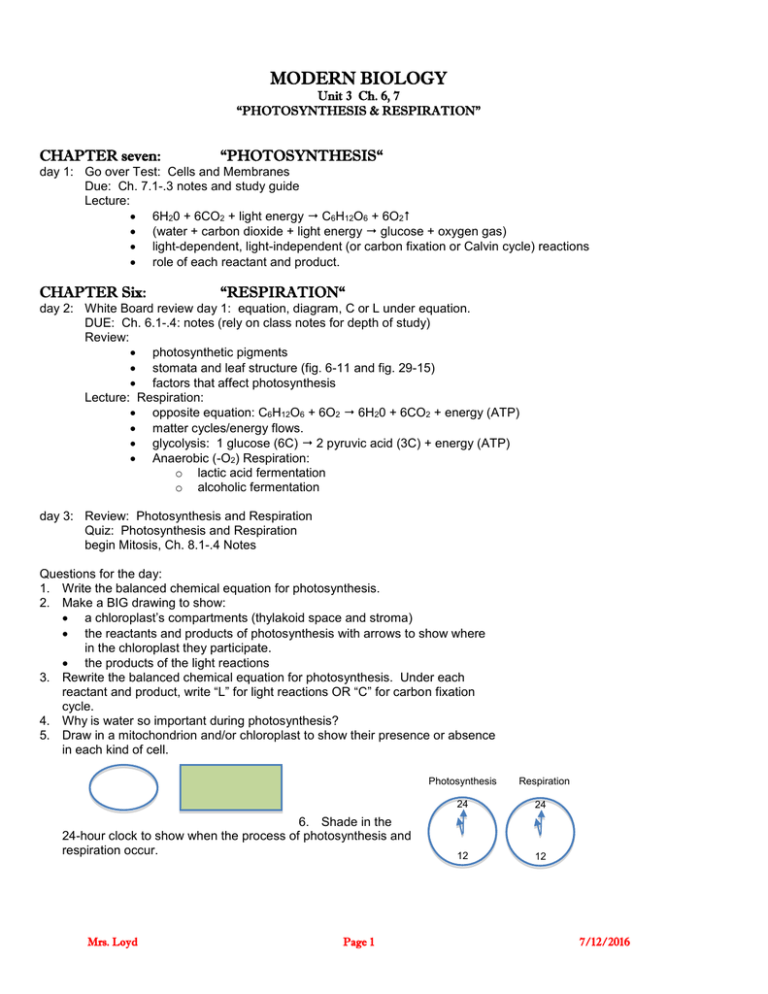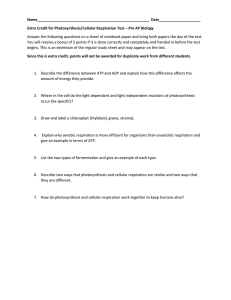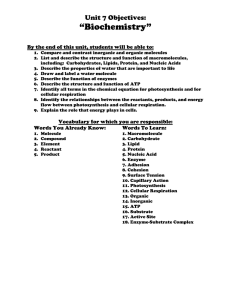MODERN BIOLOGY CHAPTER seven: “PHOTOSYNTHESIS“
advertisement

MODERN BIOLOGY Unit 3 Ch. 6, 7 “PHOTOSYNTHESIS & RESPIRATION” CHAPTER seven: “PHOTOSYNTHESIS“ day 1: Go over Test: Cells and Membranes Due: Ch. 7.1-.3 notes and study guide Lecture: 6H20 + 6CO2 + light energy C6H12O6 + 6O2 (water + carbon dioxide + light energy glucose + oxygen gas) light-dependent, light-independent (or carbon fixation or Calvin cycle) reactions role of each reactant and product. CHAPTER Six: “RESPIRATION“ day 2: White Board review day 1: equation, diagram, C or L under equation. DUE: Ch. 6.1-.4: notes (rely on class notes for depth of study) Review: photosynthetic pigments stomata and leaf structure (fig. 6-11 and fig. 29-15) factors that affect photosynthesis Lecture: Respiration: opposite equation: C6H12O6 + 6O2 6H20 + 6CO2 + energy (ATP) matter cycles/energy flows. glycolysis: 1 glucose (6C) 2 pyruvic acid (3C) + energy (ATP) Anaerobic (-O2) Respiration: o lactic acid fermentation o alcoholic fermentation day 3: Review: Photosynthesis and Respiration Quiz: Photosynthesis and Respiration begin Mitosis, Ch. 8.1-.4 Notes Questions for the day: 1. Write the balanced chemical equation for photosynthesis. 2. Make a BIG drawing to show: a chloroplast’s compartments (thylakoid space and stroma) the reactants and products of photosynthesis with arrows to show where in the chloroplast they participate. the products of the light reactions 3. Rewrite the balanced chemical equation for photosynthesis. Under each reactant and product, write “L” for light reactions OR “C” for carbon fixation cycle. 4. Why is water so important during photosynthesis? 5. Draw in a mitochondrion and/or chloroplast to show their presence or absence in each kind of cell. Photosynthesis 6. Shade in the 24-hour clock to show when the process of photosynthesis and respiration occur. Mrs. Loyd Page 1 Respiration 24 24 12 12 7/12/2016 Learning log Biology Unit #3 Photosynthesis and Cellular Respiration “I can…” statement 1. Cell Metabolism date description of activity Name: Block: score out of 4 a. I can connect anabolism, catabolism, and enzymes to the concept of cell metabolism. b. I can list the parts of an ATP molecule and draw them properly connected. c. I can demonstrate how an ATP molecule is made and broken down for energy. d. I can create an organizer that shows how anabolism, catabolism, cell metabolism, ATP, photosynthesis, and cell respiration are all connected. 2. Anabolism---Photosynthesis a. I can state the overall goal of photosynthesis, the organelle in which it occurs, and its two main stages. b. I can list the beginning and ending molecules for each of the two stages of photosynthesis. c. I can create an analogy for what occurs in each stage of photosynthesis. 3. Catabolism---Cell Respiration a. I can state the overall goal of cell respiration, the organelle in which it occurs, and its three main stages. b. I can list the beginning and ending molecules for each of the three stages of cell respiration. c. I can create an analogy for what occurs in each stage of cell respiration. 4. Summary a. I can list similarities and differences between cell respiration and photosynthesis. b. I can design an experiment that answers a scientific question about cell respiration and photosynthesis. Mrs. Loyd Page 2 7/12/2016






